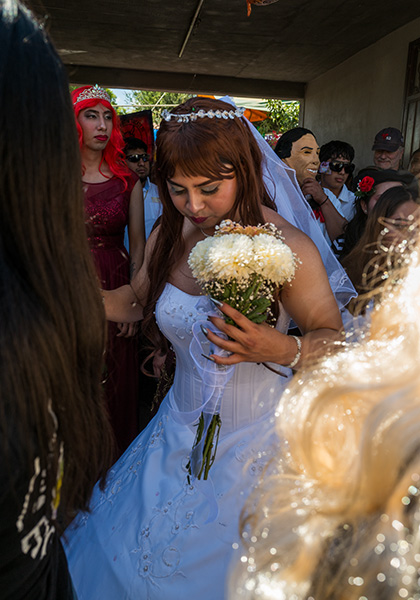For Amy and me, living just outside the city, each visit into Centro is a pilgrimage of sorts. We go not just for errands or events, but to listen. And in Oaxaca, the walls themselves have voices.
As artists, we’re always alert to surface and form. But what we find here, plastered on stucco walls and colonial façades, often stops us in our tracks. Layers of ink and wheatpaste. Stencils. Murals. Figures rising from concrete like visions.
Each outing brings fresh revelations—new works that seem to have appeared overnight. Some playful, others raw and urgent.
It’s graffiti, yes—but also graphic art of the highest order. A street-level gallery where the curators are anonymous and the exhibitions impermanent. One recurring theme we encounter is muerto—death—rendered in countless forms. Skulls, skeletons, saints of bone, eyes empty yet watching. These images, scattered across walls like quiet prophets, evoke the tradition of memento mori, reminding us of life’s fragility. They feel intimate, woven into daily life with reverence and wry humor. In Oaxaca, death is not hidden away—it dances in the open. And in that dance, something beautiful and brave emerges.
What makes the street art unforgettable is not just its aesthetic force, but its message. These aren’t just images—they’re declarations. Cries for justice. Invocations of history. Reminders of who was here first. We’ve seen faces of missing women, rendered with haunting beauty. Or portraits of Zapotec elders crowned with radiance, gazing back with dignity and warning. Even amid bright color and clever design, a fierce heart pulses underneath.
The other day, we wandered in again—my birthday, a soft afternoon. We strolled arm in arm past street musicians performing in the Zócalo, the notes of marimba and flute riding the air like butterflies. Turning down a side street, a new piece caught our eye: A slumped man, vomiting a stream not of bile, but of broken red hearts—a raw and graphic metaphor for emotional wreckage that often underlies or results from substance abuse. On his back, the phrase “Clavado en el alcohol” translates to “Nailed in alcohol” or “Stuck in alcohol”—evoking the sense of being trapped, impaled, or immobilized by addiction. A powerful play on words, conjuring both emotional and physical torment. Love, connection, heartbreak—all purged, splattered on the pavement. The hearts form a kind of visual trail; like blood drops, pointing to pain that’s been internalized too long. A street-level elegy for the many who suffer silently, and a visual cry that addiction is as much about sorrow as it is about substance. The figure is ghostlike, almost already fading, as if to say: “This is what remains when you drown your heart.”
Graffiti street art from Oaxaca—both poetic and painful.
We come in like this several times a week. The rhythm of our lives has syncopated with the city’s—market to plaza, plaza to gallery, gallery to wall. And always, the walls speak.
For two lifelong creators, there’s a special satisfaction in this: not only seeing art but being surprised by it. Art that isn’t for sale. Art that risks being torn down. Art that endures in the face of erasure. And somehow, that makes it stronger.
In Oaxaca, the city doesn’t just show you its soul. It paints it—again and again—right in front of you.






















